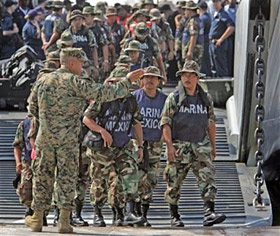 |
 |
 |
 News from Around the Americas | September 2005 News from Around the Americas | September 2005  
Mexican Army Returns to Alamo City More than 150 Years Since Historic Conflict
 Sara Inés Calderón - The Brownsville Herald Sara Inés Calderón - The Brownsville Herald


| | Soldiers from the Mexican Navy disembark from an American Navy vessel on the beach in Biloxi, Miss. The Mexican troops were helping clean-up the devastation left behind by Hurricane Katrina. (Photo: Rob Carr) |
San Antonio — Mexican soldiers in their army greens marched into this city last week with orders quite contrasted from their historic siege on the Alamo in 1836.

The dozens of uniformed troops tied on aprons and with gloved hands served soup and bread to storm shelter residents that thanked them for their kindness.

The last time Mexican troops advanced on San Antonio, the city was a battleground for what became the U.S.-Mexican War. The war’s decisive conflicts in 1848 resulted in the loss of half of Mexico’s national territory, what is now the United States’ southwest.

“Officially, Mexican troops were allowed into the U.S. around 1917 or 1918 to fight Pancho Villa,” said history professor Anthony Knopp.

“The last time they were in San Antonio would have been after Texas independence when they occupied briefly around 1842 in an attempt to reconquer Texas.”

The relationship between the two countries is familial and complicated. Conflicts over land, politics, riches, policy and culture have sometimes made accord difficult.

“You could say it was turbulent,” said Knopp who specializes in U.S.-Mexico relations at the University of Texas at Brownsville-Texas Southmost College.

After Katrina, the Mexican government offered aid to the United States by sending troops and supplies to shelters set up for storm evacuees.

The precedent for modern Mexican aid came during World War II when Mexican Fighter Squadron 201, the only Mexican unit to see combat in World War II, fought with the Allies.

Called the “Aztec Eagles,” the unit entered Texas through Laredo and trained in part on the runways of the Brownsville Army Air Field, now the Brownsville airport, according to Brownsville Herald archives.

Again arriving in Texas via Laredo on Sept. 8, President Fox’s army is helping to pick up the pieces from one of the worst natural disasters in U.S. history.

More than 40 vehicles and 200-plus soldiers, doctors, dentists and other personnel have set up camp at KellyUSA, a former U.S. Air Force Base.

“They are aid workers, really,” Knopp said.

Their presence here holds more significance for Mexicans, than for Americans he said and explained, “This gives them a chance to reverse the feeling that they are the little guy with the big brother helping them out all the time — it’s a matter of prestige.” | 
 | |
 |



